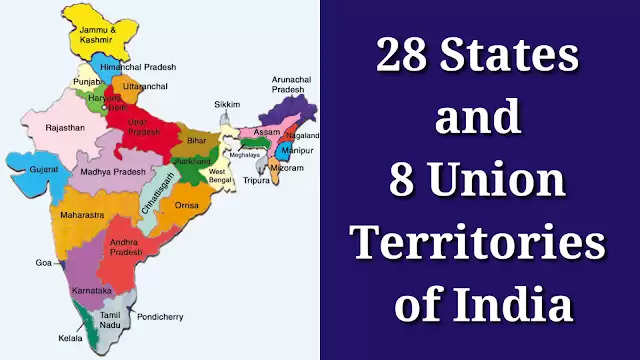Every New States and Union Territories That Are Created After 1956
Oct 19, 2021, 16:35 IST

Here is the timeline of Every New States and Union Territories That Are Created After 1956 -
- In 1960, the bilingual state of Bombay was divided into two separate states—Maharashtra for Marathi-speaking people and Gujarat for Gujarati-speaking people. Gujarat was established as the 15th state of the Indian Union.
- Dadra and Nagar Haveli were converted into a union territory of India by the 10th Constitutional Amendment Act, 1961.
- India acquired these three territories from the Portuguese by means of police action in 1961. They were constituted as a union territory by the 12th Constitutional Amendment Act, 1962. Later, in 1987, Goa has conferred a statehood,
- Consequently, Daman and Diu were made a separate union territory.
- The territory of Puducherry comprises the former French establishments in India known as Puducherry, Karaikal, Mahe, and Yanam. The French handed over this territory to India in 1954. Subsequently, it was administered as an ‘acquired territory’, till 1962 when it was made a union territory by the 14th Constitutional Amendment Act.
- In 1963, the State of Nagaland was formed by taking the Naga Hills and Tuensang area out of the state of Assam. This was done to satisfy the movement of the hostile Nagas. However, before giving Nagaland the status of the 16th state of the Indian Union, it was placed under the control of the governor of Assam in 1961.
- In 1966, the State of Punjab was bifurcated to create Haryana, the 17th state of the Indian Union, and the union territory of Chandigarh.
- On the recommendation of the Shah Commission (1966), the Punjabi-speaking areas were constituted into the unilingual state of Punjab, the Hindi-speaking areas were constituted into the State of Haryana and the hill areas were merged with the adjoining union territory of Himachal Pradesh. In 1971, the union territory of Himachal Pradesh was elevated to the status of a state.
- In 1972, the two Union Territories of Manipur and Tripura and the Sub-State of Meghalaya got statehood, and the two union territories of Mizoram and Arunachal Pradesh came into being. With this, the number of states of the Indian Union increased to 21.
- Accordingly, the 35th Constitutional Amendment Act (1974) was enacted by the parliament. This amendment introduced a new class of statehood under the constitution by conferring on Sikkim the status of an ‘associate state’ of the Indian Union. For this purpose, a new Article 2A and a new schedule (Tenth Schedule containing the terms and conditions of association) were inserted in the Constitution. This experiment, however, did not last long as it could not fully satisfy the aspirations of the people of Sikkim. In a referendum held in 1975, they voted for the abolition of the institution of Chogyal and Sikkim becoming an integral part of India. Consequently, the 36th Constitutional Amendment Act (1975) was enacted to make Sikkim a full-fledged state of the Indian Union (the 22nd state). This amendment amended the First and the Fourth Schedules to the Constitution and added a new Article 371-F to provide for certain special provisions with respect to the administration of Sikkim. It also repealed Article 2A and the Tenth Schedule that were added by the 35th Amendment Act of 1974.
- In 1987, three new States of Mizoram, Arunachal Pradesh, and Goa came into being as the 23rd, 24th, and 25th states of the Indian Union respectively.
- In 2000, three more new States of Chhattisgarh, Uttarakhand, and Jharkhand were created out of the territories of Madhya Pradesh, Uttar Pradesh, and Bihar respectively. These became the 26th, 27th, and 28th states of the Indian Union respectively.
- In 2014, the new state of Telangana came into existence as the 29th state of the Indian Union. It was carved out of the territories of Andhra Pradesh.
- Jammu and Kashmir was a state of India from 1954 to 2019, constituting the southern and southeastern portion of the larger Kashmir region, which has been the subject of a dispute between India, Pakistan, and China since the mid-20th century. After the Government of India repealed the special status accorded to Jammu and Kashmir under Article 370 of the Indian constitution in 2019, the Parliament of India passed the Jammu and Kashmir Reorganisation Act, which contained provisions that dissolved the state and reorganized it into two union territories – Jammu and Kashmir in the west and Ladakh in the east, with effect from 31 October 2019. Now, India is a federal union comprising 28 states and 8 union territories
Share this story
WhatsApp Channel
Join Now
